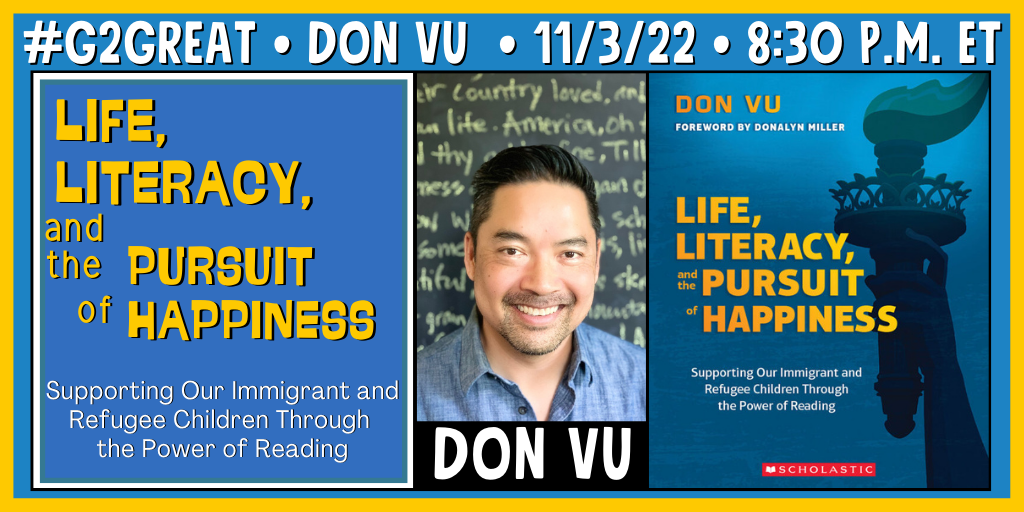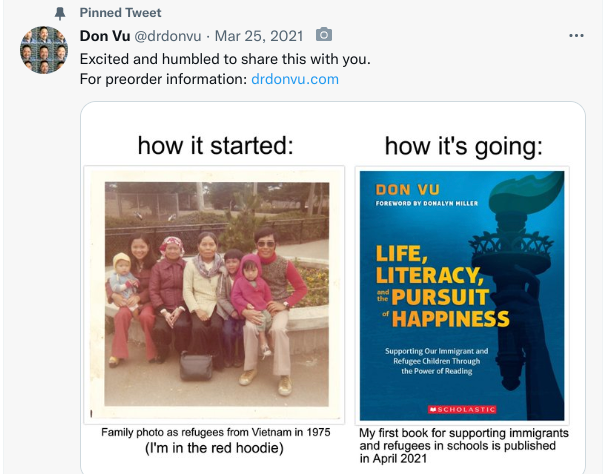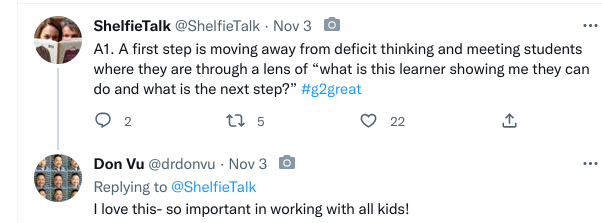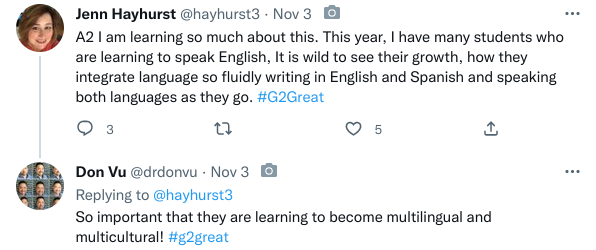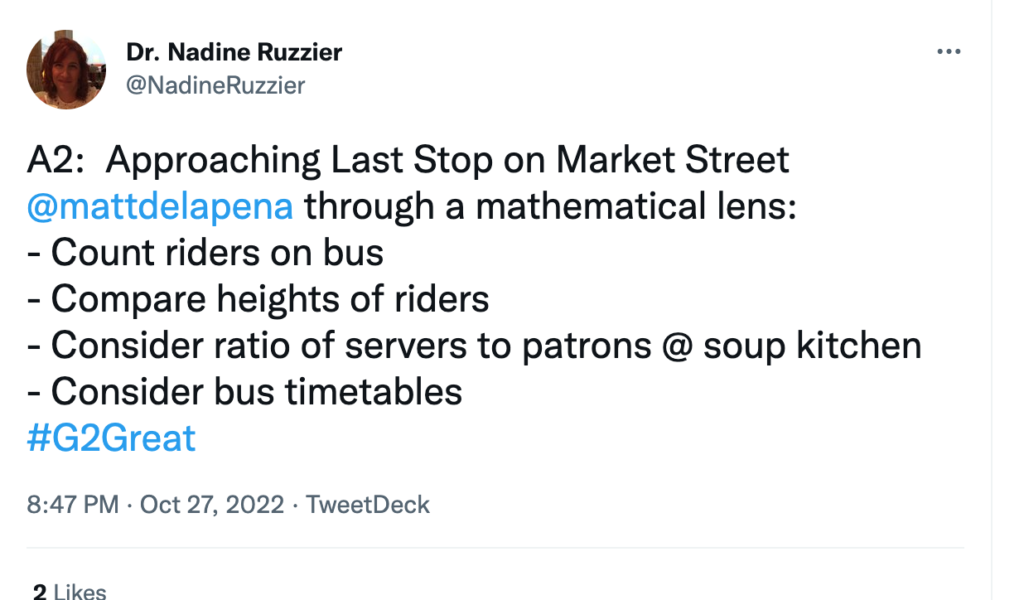Guest Author: Kitty Donohoe
On Thursday, November 10, 2022, the #G2Great Chat enjoyed a memorable conversation with Mr. John Schu regarding his book THE GIFT OF STORY.
In John Schu’s GIFT OF STORY, Katherine Applegate offers a fitting quote showing just how timely John’s book is.
“When you feel lost in the black hole of test scores and Zoom meetings, in crises big and small, in challenged titles and tight budgets, this book will be your touchstone. For every teacher and librarian and parent who’s placed the right book in the right hands at the right time, THE GIFT OF STORY is a reminder that you are not just molding minds, you are nurturing souls.”
And many of us know what that is like, and yet when we stick our heads out of the mire of all the “yuck” we experience, magic can happen. When we remember that story truly is a gift, when we remember the little ones who benefit from those stories, we are reminded of what is important. When I taught on Zoom school for a year, I forgot there was a pandemic whenever I saw the dear faces of my second grade students reflected on the screen. And in Grace Lin’s book WHEN THE SEA TURNED TO SILVER, there is a wonderful quote about stories. A stonecutter and a storyteller are imprisoned by the villain of the story. However, this is what the stonecutter says: “For to be in prison with the Storyteller is to not be in prison at all.” Stories set us free, wherever we are physically, we are in the story mentally. Grace Lin got me and my second graders through lockdown, and that is a gift indeed.
The Good to Great Twitter Chat featuring John Schu offered educators, librarians, and parents, a chance to join in and celebrate the joy of stories. We shared our stories with each other and in the process exchanged book ideas, and came out a little fuller, a little happier, because that is what happens when you share stories. That is what humans have been doing since before there was even the written word. We shared stories, we felt joy, and we drew closer to each other in the exchange. That is how community is formed.
While I have never met John in person, I have met him on Zoom and through social media. This quote from the book and the experience of those who know him well is so true. John Schu is infectious with joy. This was so evident in the chat. And we all know that this love of books he so avidly shares with others has created a worldwide pandemic of joyful reading for young readers. And isn’t that the kind of pandemic we all want to happen?
In his book, THE GIFT OF STORY, John includes quotes from authors regarding their experiences with story. This quote from Dav Pilkey really speaks to so many young readers who can relate to the challenges that one of their favorite authors had.
This is so pertinent. How often have we as educators, teachers, or librarians, seen joy light the face of a child who sees themself reflected in the pages of a book. For books are magic, they can say: I see you, I hear you, I know you. And everyone needs this!
These are words of wisdom from Fran McVeigh, making room for reading both physically and mentally. And choice, choice, choice!
Dr. Mary Howard points out basically how we have a choice in education. What are we going to choose? Are we making time for stories for children? Or are we NOT? It is up to us.
Often when I get overwhelmed with all the mandates imposed upon teachers I find myself unable to concentrate and focus. My planned day wavers before my eyes as more and more is expected of educators and children. But then suddenly, I spy the pile of read aloud books I have on my desk and they shout out to me, “Remember us? Your old friends? Your new friends?” And then, the calm comes, the antidote for all the chaos – a good story. John reminds us of the importance of story. And the books truly do call out to me and the students. When the classroom reading life is in order, everything else magically falls into place.
Wow, click on that link readers and discover wonderful books to add to your read aloud pile, or your classroom library! We all need new ideas for books to share with kids.
Click on this link to see the list of even MORE books Mr. Schu suggests! What a treasure trove!
And another great book idea resource! Click on the link to see the article!
This chat was a joyous exchange of a shared love of BOOKS and STUDENTS READING!
In his book, John has organized and curated tremendous resources. This is done in an innovative and helpful way.
One thing he does is to have short book reviews of myriads of books throughout THE GIFT OF STORY. It is so user friendly. Busy educators and librarians can thumb through it at-a-glance when looking for resources.
A very clever and creative device Mr. Schu uses throughout his book is his use of hearts to tie it all together. One of my favorites is the embedded QR codes in hearts. One section of his book has book trailer links in the hearts like this:
Another lovely way he incorporates heart embedded QR codes includes links to articles like this one by Dr. Sayantani DasGupta, pediatrician and children’s author:
“Stories Are Good Medicine: Literacy, Health, and Representation”
There are so many other wonderful resources in Mr. Schu’s book THE GIFT OF STORY. I would have to copy and paste the whole book in here in order to mention them all. But you can get them in this marvelous book that is a true friend to all who love books and want to pass this love around, just like Mr. John Schu!
Thank you Mr. Schu for being a light for children and book lovers all over the world. Thank you #G2Great Chat for making a space each Thursday evening for like-minded people to come and share their stories. We all see you and appreciate you. We are a community!
_ _ _ _ _ _ _ _ _ _ _ _ _ _ _ _ _ _ _ _ _
About Kitty Donohoe, this week’s guest blogger:
Kitty Donohoe teaches second grade just a gull’s cry from the Pacific Ocean at Roosevelt Elementary in Santa Monica, CA. Her debut picture book, HOW TO RIDE A DRAGONFLY, illustrated by Anne Wilsdorf, comes out May 23, 2023. Publisher: Penguin Random House/Anne Schwartz Books
